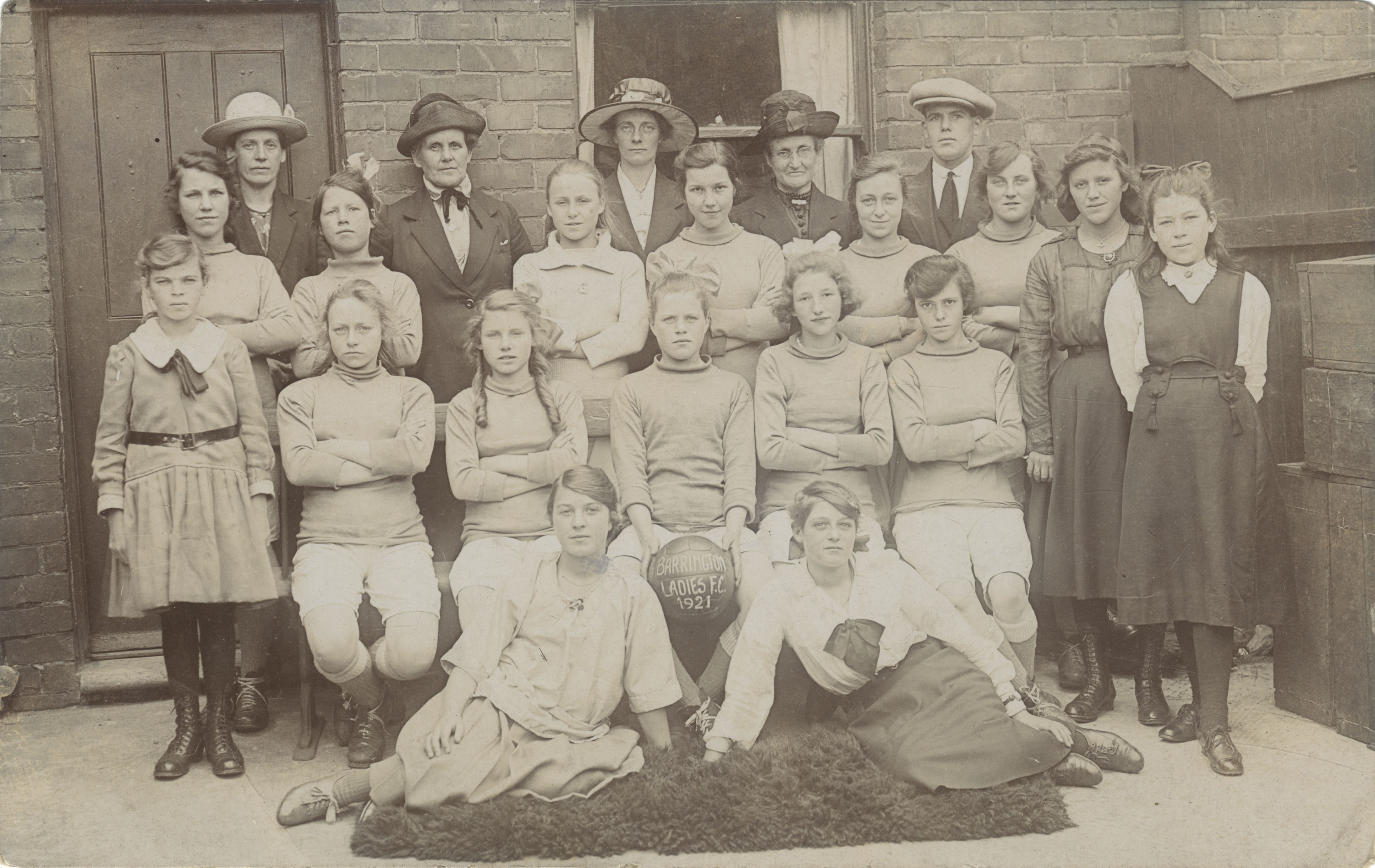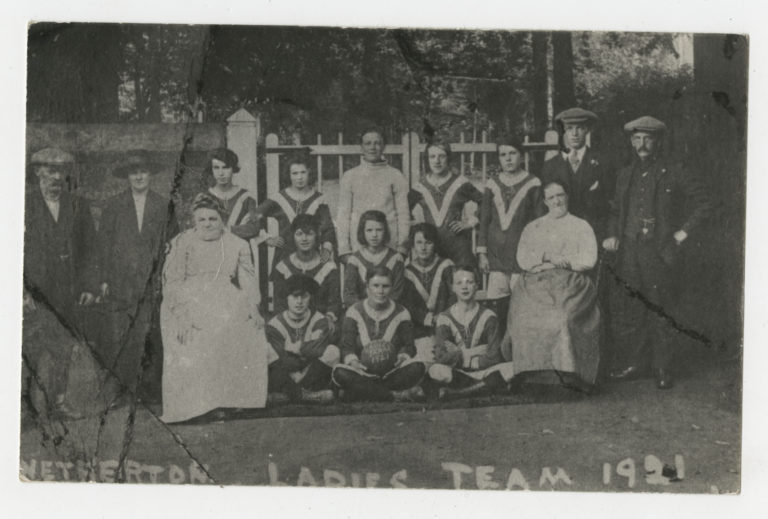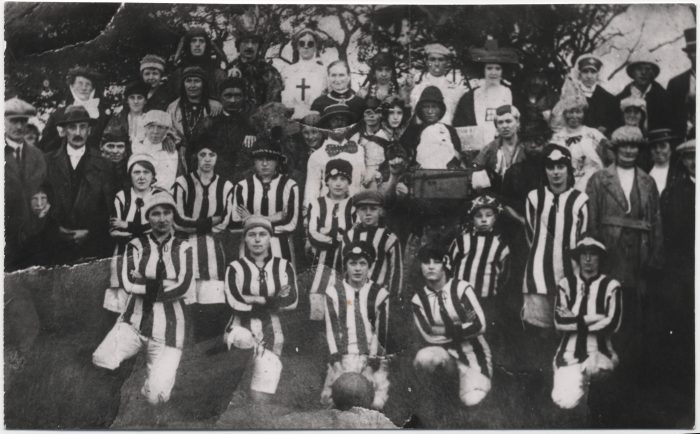Photograph of three women’s football teams, 1921
Reference: NRO 05283/C/18/57, NRO 05283/GI/2, NRO 07990/2/7
Suggested age groups: KS1, KS2, KS3, KS4, Lifelong Learners
Subject areas: Literacy, Citizenship, Physical Education
CONTEXT
During the First World War women worked in factories and industries that they had not traditionally worked in before. Many of these workplaces had football teams; when women started working in these workplaces they also started their own teams. (See Lizzie Holmes oral history below).
The Football Association suspended matches during the war and many footballers joined the armed forces. The gap that was left was filled by women’s football. Matches were played across the country, mainly as charity events to raise money for injured soldiers and sailors. Popularity grew and matches were played in large venues in front of thousands of spectators, including at Saint James’s Park in Newcastle.
Then, as now (2020), some of the best women’s footballers in the country came from the North East. Bella Reay played for Blyth Spartans who won the Munitionette’s Cup in May 1918. Bella scored a hattrick in the match which Blyth Spartans won 5-0. Mary Lyons also played for Blyth Spartans, although she also played for Palmers. Mary is the youngest England international football player, male or female, as she played from her country aged just 15 years. (See below)
In spite of the popularity of women’s football, the Football Association banned women from playing on their pitches in 1921. As men returned from the war, women were expected to make way in the workplace and many did so willingly. But, without the organisation around the workplace and with the FA ban, women’s football went into decline. (See Lizzie Holmes oral history – she gives her football kit to her husband to wear as pit clothes.)
The photographs show the following teams:
Top: Barrington Ladies (NRO 07990/2/7)
Middle: Netherton Ladies (NRO 05283/GI/2)
Bottom: Ashington Ladies (NRO 05283/C/18/57)
ACTIVITIES
ACTIVITY 1
Background
During the First World War women worked in factories and industries that they had not traditionally worked in before. Many of these workplaces had football teams; when women started working in these workplaces they also started their own teams.
The Football Association suspended matches during the war and many footballers joined the armed forces. The gap that was left was filled by women’s football. Matches were played across the country, mainly as charity events to raise money for injured soldiers and sailors. Popularity grew and matches were played in large venues in front of thousands of spectators, including at Saint James’s Park in Newcastle.
SEE
See: What types of industries did women work in during WW1?
See: Why did women start playing football during WW1?
See: What was the Munitionette’s Cup?
See: How did women’s football matches help the war effort?
THINK
Think: How did the role of women change during WW1?
Think: Do you think attitudes towards women changed due to their work during WW1?
Think: How do you think women felt about doing these jobs?
Think: How might women’s football have contributed to morale during WW1?
Think: What happened to women’s jobs in these industries after the war ended?
DO
Do: Using the characters from the Darlington newspaper letters, in groups debate for and against women playing football.
Do: Using the information from the Donmouth website, write a report of one of the football matches for a local newspaper. Include players names, goal scorers and the size of the crowd, where possible.
Do: Research a current footballer from the England Women’s squad. You may want to research one from the North East – Lucy Bronze is from Berwick/Holy Island and Lucy Staniforth is from Alnwick.
Do: Imagine a conversation between a WW1 woman footballer and a woman footballer of today. What would they say to each other – what has changed and what has stayed the same?
Resources
ACTIVITY 2
Background
In spite of the popularity of women’s football, the Football Association banned women from playing on their pitches in 1921. As men returned from the war, women were expected to make way in the workplace and many did so willingly. But, without the organisation around the workplace and with the FA ban, women’s football went into decline. (See Lizzie Holmes oral history – she gives her football kit to her husband to wear as pit clothes.)
SEE
See: What did the Football Association do to women footballers in 1921?
See: What did Lizzie Holmes do to her football kit once her husband returned home from the war?
See: Why did women’s football fall into decline after the end of the war?
THINK
Think: What reasons did the Football Association give for banning women from playing on their pitches in 1921?
Think: Do you think the official reasons given by the Football Association were the real reasons they banned women’s football? Write a list of the other reasons that could have led to this.
Think: Why do you think women were willing to make way for men in the workplace after the war?
Think: Do you think women returned to their pre-war roles and lifestyles after the war ended?
DO
Do: Do you think there is more equality in women’s football and women’s sport today than there was during WW1? Create a presentation showing how equality in women’s sports has evolved over the last 100 years. Are there areas that could still be improved?
Do: Write a poem or monologue using Lizzie Holmes oral history as inspiration. How did she feel when played football? How did she feel when she had to give it up? Perform your piece of writing.
Do: Read History Extra’s article about the Football Association banning women from playing on their pitches. Write a conversation between a member of the Football Association and a women’s football player showing their different perspectives on the ban.
Do: Research some of the WW1 women’s football teams and players. Design your own football tournament featuring the teams and put together your own fantasy football team.
Resources
OTHER ONLINE RESOURCES
History Extra website, page about banning of Women’s Football by Football Association in 1921: https://www.historyextra.com/period/first-world-war/1921-when-football-association-banned-women-soccer-dick-kerr-ladies-lily-parr/
Facebook website, Chanel 4 page with clip from Clare Balding film: https://www.facebook.com/watch/?v=10154526249557330
The Football Association website, page about women’s football: https://www.thefa.com/womens-girls-football/history
Durham at War website, page with Darlington newspaper letters for and against women’s football: https://www.durhamatwar.org.uk/material/588/
Durham at War website, page for Lizzie Holmes’ oral history about playing football and having to give up at the end of the war: https://www.durhamatwar.org.uk/material/113/
Durham at War website, profile of Mary Lyons who played for Blyth Spartans: https://www.durhamatwar.org.uk/story/12720/
Spartacus Educational website, page about women munition workers and their football teams: https://spartacus-educational.com/Fmunition.htm
Blyth Spartans
Wolverhampton University website, pdf of paper on Blyth Spartans Ladies during WW1: https://www.wlv.ac.uk/media/departments/faculty-of-social-sciences/documents/football-and-war/FootballandWarBlythSpartansLadiesArticle-2019.pdf
Donmouth website, page about Blyth Spartans: http://www.donmouth.co.uk/womens_football/blyth_spartans.html
Donmouth website, page listing Munitionette football games in the newspapers: http://www.donmouth.co.uk/local_history/great_war_football/munitionettes.html
Blyth Spartans Football team website, page about plaque for Bell Reay: https://www.blythspartans.com/news-plaque-unveiled-for-spartans-legend/




